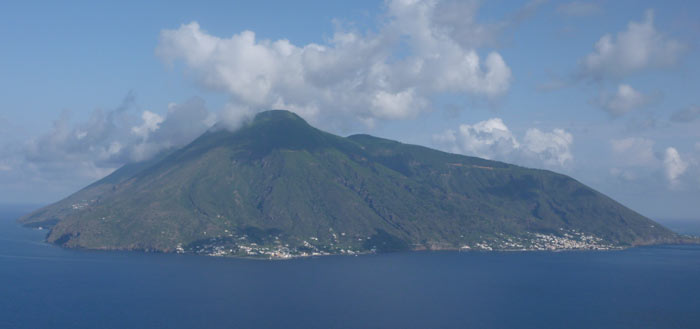About Salina
Salina is the ‘green’ Aeolian island, where little vineyards produce white island wine, colourful flowers clamber rampantly among picturesque village houses, and visitors enjoy laid-back holidays away from tourist hubbub, underneath the island’s twin green peaks; extinct volcanoes. This is the island for losing yourself in a more authentic island life, for strolling through village lanes, and for eating excellent meals of local produce at reasonable prices as well as sampling the sweet Malvasia wine.
> About the Aeolian islands
> Find somewhere to stay on Salina (or read on for recommendations)
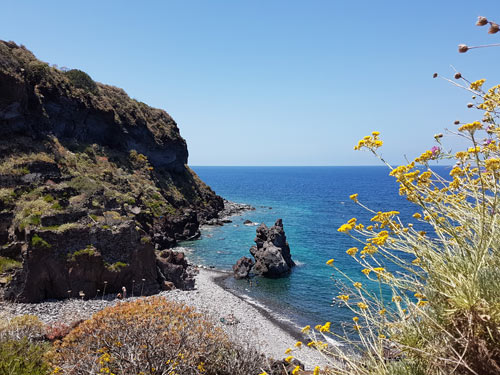
Administratively as well as in atmosphere, Salina is set apart from the other Aeolian islands. While all the other islands are part of the Comune (council district) of Lipari, Salina has three small comuni of its own, Malfa, Santa Marina Salina and Leni, their villages spread around the slopes of the island. The island has two ports used by the hydrofoil and ferry services, Santa Marina Salina and Rinella. It also has a couple of small museums, a handful of small mostly-pebble beaches, several walking routes including footpaths up the taller of the two island peaks, and offers the usual island activities of pottering, swimming, boat trips, eating and drinking.
Visitors who are well-acquainted with the Aeolian islands all rave about Salina; its charms are quiet and discreet and the vibe isn’t so much sun, sea and disco as rustic, romantic and quaint. Spread around the coast and over the fertile slopes of the two volcanic peaks are several villages connected by road and by the little island bus. Like the islands, each of the villages on Salina has its own character and makes a different type of holiday base. I’ve stayed in Lingua, Santa Marina Salina and Malfa and found all three appealing in different ways.
Santa Marina Salina
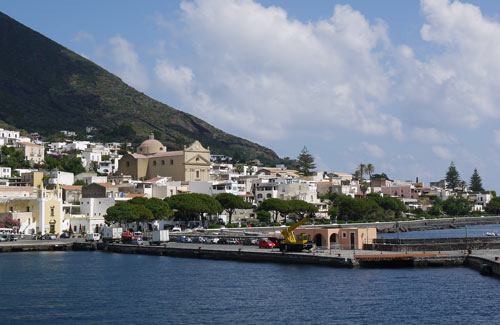
Santa Marina Salina is the principal port on the island. A small and picturesque ‘town’, although really it’s not much more than village-sized, it has a more urban and cosmopolitan atmosphere than you’ll find elsewhere on Salina. Beneath wooded slopes descending from the island’s highest peak, Fossa delle Felci, the heart of town is essentially two streets: one small waterfront road which links Santa Marina to the other villages, and one pretty pedestrianised ‘high street’ running uphill just inland from the harbour and church. Here you’ll find restaurants, cafés, take-away Sicilian street food, small grocery stores and tourist boutiques selling souvenirs, island fashions and local food products.
The quaint village-y atmosphere – you only have to visit a couple of times and shopkeepers will remember you – and the scenic seafront location with views of Lipari make it a charming place to stay, if a little more ‘touristy’ in feel than other Salina destinations. The regular ferry services make this a practical base if your time on the island is limited and if you want to visit other islands. If you’re on a budget this is also a good choice, as the bus timetable can be limited out of peak season, meaning if you stay elsewhere on the island you may need to pay for taxis on arrival and departure.
Malfa
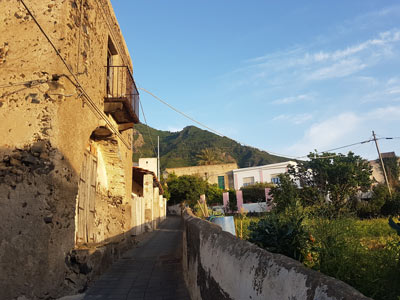
Staying in Malfa in spring or early summer, among greenery, bright flowers and butterflies, is a dreamy experience. This rural village has a decent-sized resident population, living in dwellings spread over a wide area among vineyards and fields, where green cultivated slopes descend gently from the foot of Fossa delle Felci towards low rocky cliffs at the seashore. The heart of the village is simply one sleepy crossroads next to a church, where a terrace provides sea views and a place for children to play football, café tables offer a view of the world going by, and a handful of shops and restaurants are strung along a narrow street. Elsewhere, white-painted island houses are set among gardens and vineyards and agricultural terraces, connected by a slowly sweeping road and by the old mule lanes which still provide pedestrians with the most direct routes around the settlement. For those passing through in a hurry, there isn’t much to see. But stay here a few days, or even a few hours, and visitors will begin to feel the mellow seduction of the scenery, the ambience and the hospitality of Malfa.
Tourism has come to Malfa, so far, in a gentle and classy way. Set discreetly among flower-draped alleys are a handful of refined but unpretentious places to stay, from welcoming B&Bs to upmarket hotels with pools. Most of the buildings in Malfa are in quiet and traditional island style, and many along the oldest alleys are picturesque, ancient and sometimes crumbling. Families of feral cats dart out at dusk, roses scramble up dilapidated façades, and caper plants bloom among fallen masonry. The current state of development, with an authentic rustic feel and a ‘living’ village atmosphere, combined with partial restoration of the historic houses and a certain degree of gentrification, is what makes Malfa feel so quietly special and attractive to visitors. Perhaps it’s a fragile equilibrium, as without its quiet corners, its picturesque decaying buildings and its rusting wrought-iron doorways, the village might become another purely tourist destination, with every building smartened-up for tourist accommodation. But for now, at least out of the peak July-August period, this is a village where tourists can live comfortably while being absorbed into the peaceful rural island atmosphere.
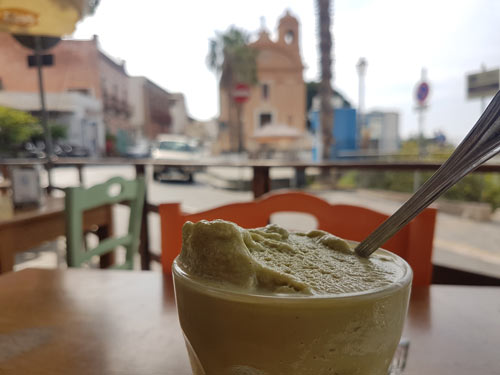
While Malfa doesn’t have many specific tourist sights, it’s easy to spend a couple of hours exploring lanes, taking photographs and admiring the scenery. Uphill from the centre, behind the church of San Lorenzo, is an interesting little museum of emigration, dedicated to the many islanders who headed to Australia and America in search of a better life (check locally for opening times). In the opposite direction, Via Scalo, Malfa’s most picturesque alley, leads downhill past handsome buildings, ruins, flowers, vines and agricultural terraces towards the sea. Crossing the road by the panoramically-positioned Hotel Punta Scario, a lane descends around the cliffs to Malfa’s small stony beach, known as Lo Scario. Here you can rent inflatable mattresses, parasols and sunbeds and enjoy the beach’s beautiful surroundings. There’s a little café shack at the back of the beach, ruins on the slopes above and a lovely atmosphere, busy in the height of summer, but peaceful at other times. Climbing back up to the road by the hotel, turning left and then heading downhill will take you to Malfa’s harbour, a small and curious place with a somewhat forgotten air, where old fishermen’s houses cluster together and small pleasure boats rock at their moorings.
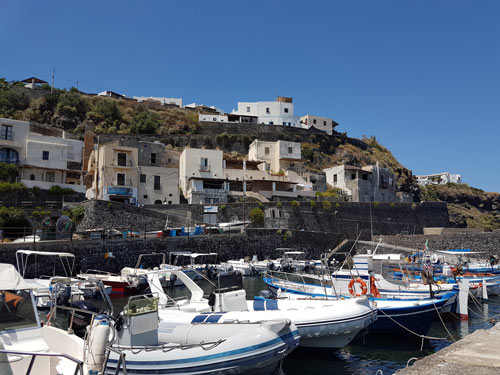
There’s a finite but good choice of places to eat in Malfa. As well as a handful of take-away and convenience options – including a small supermarket where you can buy cheap picnic provisions and rolls made while you wait – visitors will find several excellent restaurants serving traditional island and Sicilian cuisine, often using locally-grown ingredients. La Pinnata del Monsù, just outside the village centre with vineyard and sunset views, offers sophisticated and tasty versions of traditional dishes, with excellent rustic antipasti, pasta and fine desserts. In the heart of Malfa, U Cucuncio is a popular pizzeria, while Trattoria A Quadara serves good quality local cuisine. For drinks, the garden bar of Hotel Ravesi is a classy option for an aperitivo, where a choice from the cocktail or wine list can be enjoyed with substantial self-service nibbles. For a romantic drink, the outdoor bar In Sé Natura perched on the cliffs above the rocky beach makes an atmospheric after-dark destination.
Island buses stop in Malfa’s central piazza, and connect the village with Santa Marina and Lingua in one direction, and Leni and Rinella in the other. If you’re staying in Malfa and arriving by bus, ask your hotel or the driver which is the best stop. Another infrequent bus service runs to Pollara, so by planning around bus timetables, it’s possible to tour the island and see Salina’s other sights quite easily.
Lingua
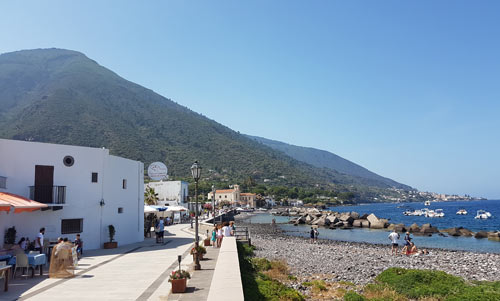
Lingua is a little settlement at the end of the coastal road south from Santa Marina Salina. It’s a very pleasant place to stay for a few hours – or a few days, if you are looking for a laid-back seaside break. Lingua basically consists of a short promenade walk along the sea, a tiny piazza full of café/restaurant tables, some scattered dwellings inland, and an ancient salt lagoon. The salt pans here, now consisting of a single large pool, were in use in Roman times and gave the island of Salina its name. Overlooking the lagoon is the Museo Civico, an interesting museum of local traditions, with artefacts and exhibits relating to Salina’s history and industries, from fishing to caper-harvesting (check opening times locally).
Beneath the low wall of the promenade is a very narrow strip of beach, made of stones and large pebbles. In front of the beach is a shallow stretch of crystal clear water, protected from the open sea by the giant blocks of a breakwater. This tranquil area is ideal for novice swimmers, children, for wading, or for perching on a smooth underwater rock and relaxing in the cooling waters. A further stretch of pebbly beach, open to the sea, can be found further along by the salt lagoon. And past the lagoon along the seashore is a lido with sunbeds for a more comfortable experience.
There are several hotels, rooms to let and restaurants at Lingua. The most renowned eatery is Da Alfredo, famed for both its fresh fruit granita (the classic Sicilian ice-slush, rated as one of the best in Italy) and local speciality pane cunzato, a kind of seasoned bread piled high with local ingredients. There are tables in the square overlooking the sea, and a restaurant just behind the square. Pane cunzato makes a good lunch or simple evening meal; the portions here are big, but they also serve half-portions on request. If you’re visiting Salina, every Italian will tell you that Da Alfredo is an unmissable destination, and many travel here just for the granite, sampling flavours like fig, wild island blackberry, mulberry, almond, peach and prickly pear, sometimes combining two together.
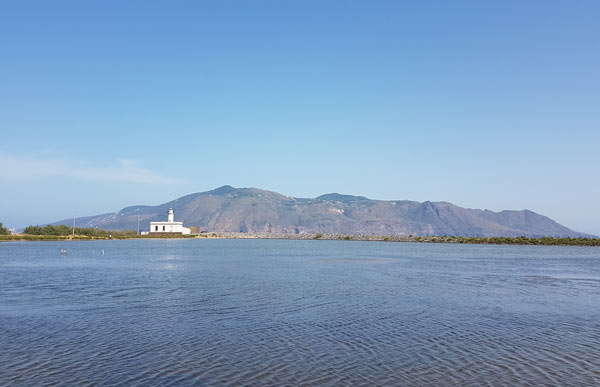
Lingua is a good destination for an excursion, reachable by bus, taxi, hired vehicle or on foot from Santa Marina. The walk takes about 45 minutes and is scenic – but with the need to be wary of the occasional passing traffic on tight bends. Look out for an old bridge dating to an earlier incarnation of the road. Take note of the bus timetables; although Lingua is a great place to visit for an evening meal on the seafront, you may find there are no evening buses, so be prepared to use a local taxi afterwards.
The village fills up at summer lunchtimes when excursion boats from Lipari discharge their passengers, and the café tables are thronged. At other times it can be very tranquil and although the centre is touristy, it is touristy in a very low-key and unpretentious way.For holidaymakers who are staying in Lingua, the day is spent going out on a hired boat or on an organised boat trip, lying on the stones of the beach (some people use inflatable mattresses for comfort), swimming, cooling down with a granita, eating pane cunzato, and browsing the little artisan knick-knack stalls along the seafront. Children play together in the sea pools, and in the evening they trundle up and down the pedestrian promenade on scooters, bikes and skates. At night, away from the lights of the seafront, the sky is full of stars.
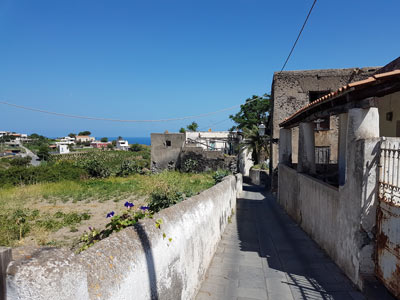
If you’re looking for more energetic activities, the rest of Salina is reachable by the bus, which starts in Lingua before heading to Santa Marina, Malfa, Leni and Rinella (change in Malfa for Pollara; ask the driver). A scenic footpath also starts in Lingua, beginning along the seashore past the salt lagoon. By La Salina lido, take a long straight alley uphill, turn left on the road to its end, then follow the signposted footpath (I ignored a barrier and a sign warning of the lack of railings and slippery surfaces). This path, known as the Sentiero Brigantino, winds along the coast for around 45 minutes’ walking before petering out in the Mediterranean scrub. On the way it passes close to a picturesque isolated rustic house standing overlooking the sea among terraces of olives and capers. There are good views of other islands: Lipari, Vulcano, and, later, Alicudi and Filicudi, as well as closer views of the typical old agricultural terraces, where fig trees, prickly pears and olives still grow. Note though that there is practically no shade from the sun’s heat, and that much of the outward route climbs steeply, mostly stepped, so this can be a demanding hike in hot weather.
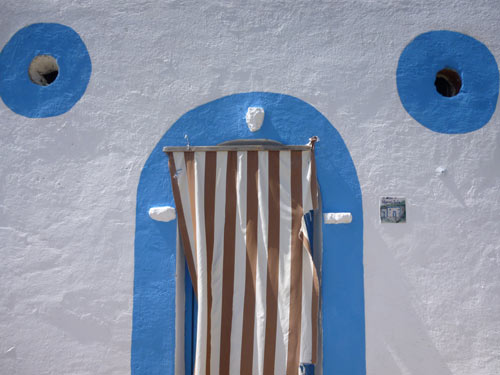
Other things to do and see on Salina
The fishing village of Rinella is another photogenic location, and has the benefit of a small sandy beach, the only one on the island. Reachable by both bus and ferry, it can be worked into an enjoyable round trip if you study timetables. From the winding road above the port a footpath leads along old terraces above the sea to the headland of Punta Megna, which makes an interesting short excursion offering great views. There’s a seasonal refreshment kiosk along the coast here, a tiny panoramic amphitheatre, and access to another pebble beach, Spiaggia Pra Venezia. On the slopes above Rinella is the larger, picturesque village of Leni.
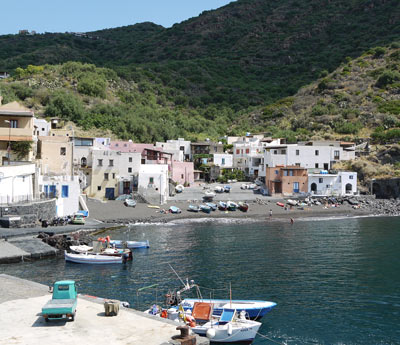
Pollara, reached by bus from Malfa (check the timetable for connections, as there can be long gaps), is a must-see destination for most visitors to Salina, and a popular spot for sunset-watching. This bay is set in a huge rocky semi-circle, part of an unmistakeable ancient volcanic crater. The 1994 film Il Postino was partly filmed here, taking advantage of the dramatic scenery. The ‘poet’s house’ from the film is among the movie’s locations here in Pollara, and both here and elsewhere on Salina visitors will encounter memorials to the film and to its star, Massimo Troisi. Down a lane past the church, a path leads down to the rocky seashore beneath the cliffs, where modern visitors sunbathe and swim in front of cave-buildings used by fishermen of times gone by. There are sunbeds for hire. Pollara is a small and quiet settlement, with just a very few places to stay, and an agriturismo (Al Cappero) for lunch or dinner.
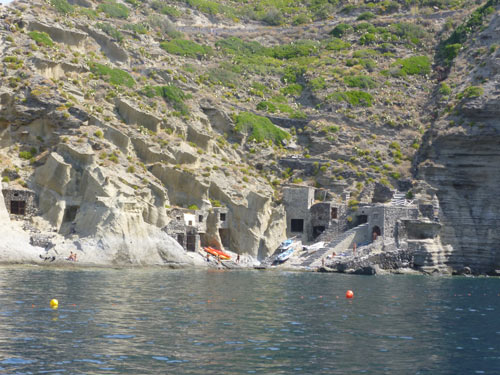
Keen walkers staying on Salina will make it a priority to take the footpaths leading up to the Aeolian islands’ highest peak, Fossa delle Felci (968m). The most popular hiking route is from Val di Chiesa, the valley between the two peaks, where a forestry trail leads up from a small church. This takes broad zig-zags; there is also a more picturesque and more direct footpath. The route is shaded by trees most of the way; not so good for views but convenient in hot weather. The summit cairn offers views, and along the upper ridge are views of the old volcanic crater, now filled with trees and vegetatiion – the name Fossa delle Felci means Hollow of the Ferns. A number of other trails lead away from the summit. I took a very steep route down to Santa Marina Salina, which I wouldn’t recommend as a descent; there were alternative signposted trails, though, including one to Lingua. Although walking maps of the islands are unreliable, by combining a map with asking for up-to-date local information it should be possible to plan further routes. There’s a bus stop at Val di Chiesa; make an early start if the weather is hot, and take ample water, food and sun protection.
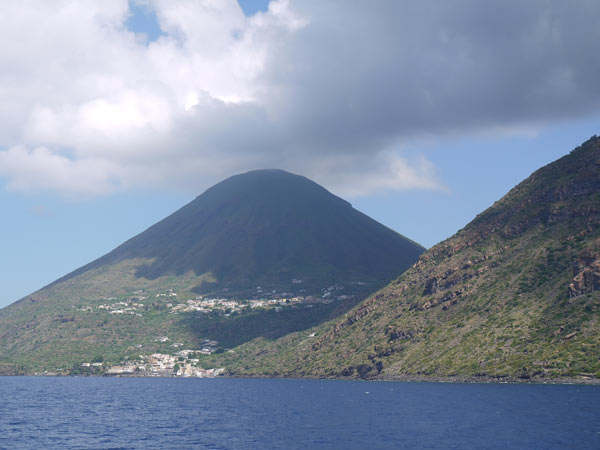
Some of Salina’s slopes are steep and wild, and pretty much unreachable; there are no roads which circumnavigate the island. The island bus route follows the main road, beginning at Lingua, passing through Santa Marina and climbing past the lighthouse and vineyards of the Capo Faro headland to Malfa. From here, sometimes with a change of vehicle, it heads between the two island peaks at Val di Chiesa, and descends through Leni to the seashore at Rinella. Timetables vary throughout the year, and the winter timetable, generally in use as late as June, only has infrequent services which typically stop at about 6pm. Some visitors choose to hire cars or scooters to travel more freely around the island; there are also taxis which offer scenic tours as well as direct connections.
To see the whole coastline of the island, the best and only way is to take an organised boat excursion or hire a boat (available with or without skipper). Most tours circle the island with breaks for swimming, with a stop at Lingua. Highlights include views of Pollara from the sea, where as well as the bay, sights include a large rock arch, one of Salina’s chief landmarks. Some boat trips combine Salina with Lipari, and other organised excursions visit the other Aeolian islands, including the favourite island activity of visiting Stromboli in the evening to witness volcanic eruptions after dark.
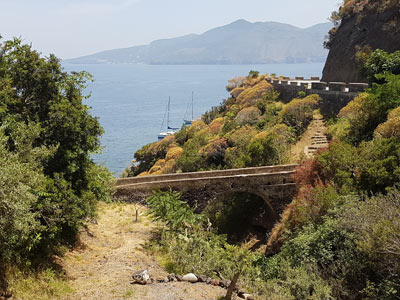
When to visit
Like most Italian islands, Salina is at its best in May and June when the landscape is green, flowers are at their peak, the weather is usually reliably warm, and most tourist services are up and running. July and August are Italy’s summer holidays and even peaceful Salina suffers under the onslaught of mass tourism. Temperatures can be sweltering too, although sea breezes make the islands more comfortable than mainland Italy. September is often hot at the beginning of the month, leading into stormy weather, but early autumn can still be a good choice for travel as the islands settle into a quieter mood with the grape harvest as a local highlight. Salina hotels typically open from Easter to October and prices will be cheaper outside peak travel times. The island buses tend to operate a ‘winter’ timetable from September till June, with less frequent services, which is a slight drawback if you’re relying on public transport.
Where to stay on Salina
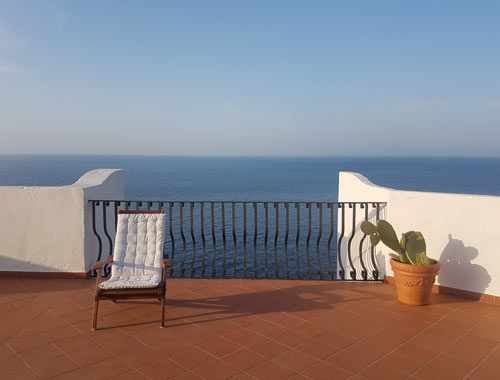
Where to stay on Salina depends upon your budget and priorities. For convenience of ferries, transport and shops and for a livelier atmosphere, Santa Marina is the best choice. Rinella too has both charm and ferry connections. Lingua is an appealing base for a summer break right by the sea, with a cheerful touristy seaside character and its little handful of waterfront bars and restaurants. Lovely Malfa is an excellent choice for fans of the peaceful and the picturesque, though it should be noted that, despite its beach and fishermen’s hamlet, it feels more rural than seaside-y. My favourite base was Malfa, possibly because it has been the most recent. I had already explored the island on previous visits though, and enjoyed the sea at Lingua, so I wasn’t a typical first-time visitor, but felt able to relax and sink into the charmed atmosphere of the green village.
In Malfa I stayed at Hotel Punta Scario, which has an unmatchable location perched right over the cliffs and has lovely nooks and terraces to relax and enjoy the views. More expensive, and tucked away among greenery nearer the heart of the village are Hotel Ravesi and Hotel Signum, two classy options pioneering upmarket low-key tourism here. Even if you’re not staying there, Hotel Ravesi is worth visiting at aperitivo time for a drink in the garden bar accompanied by nibbles. There are also a number of popular and welcoming B&B and apartment options including ‘A Alera Room & Breakfast.
In Santa Marina Salina I stayed at the charming Hotel Santa Marina where my room had elegant traditional island furnishings, and the little roof terrace had glorious views across the sea to Lipari.
In Lingua my choice was Hotel A Cannata, where the simple bedrooms have external access from little courtyards and lanes. It’s just yards from the waterfront restaurants and the sea; I wandered out after dinner to sit on the sea wall and watch the moon rise.
Although the villages are diverse, if you stay for a few days on Salina you’ll be likely to visit all of them, and while each would give a different mood to your holiday if chosen as a base, if you think you’d like the green, unpretentious charms of Salina, you will probably enjoy an excellent holiday wherever you choose to stay.
> Salina hotels, B&Bs and apartments
Travel to Salina
You can find more information on reaching the Aeolian islands from Sicily, Italy and other countries on the Aeolian Islands homepage. Salina is the third port of call for most hydrofoils from Sicily, so it is one of the easiest and quickest of the islands to reach. It is always important to check ferry timetables closely in advance of travel – times can be irregular. If you have time to spare and are travelling at a suitable time of day/day of the week, it can be enjoyable to take a slower car ferry with outdoor decks offering views. In the summer there are lengthier services from Naples which call at Salina. The principal port for the island is Santa Marina Salina, but some ferries call at Rinella, so if you are staying in Rinella or Leni, this will be a more convenient option, subject to timetables.
Taxis can be caught at a rank by the port, or ordered in advance – hotels are very helpful at arranging transfers. There is a bus stop very close to the port in Santa Marina Salina. The bus route is described above, and timetables are available online (see links panel on the right). You can pay the driver for single or return fares, or buy an abbonamento of 12/40/60 single journeys. If you’ll be catching several buses in a day, ask about a ‘giro dell’isola’ (a day ‘island circuit’) ticket.
As always when visiting islands, bear in mind that high winds and stormy seas can lead to the cancellation of hydrofoil services and also, less often, of the larger ferries which shuttle between the islands. It’s advisable to travel with a flexible attitude and be prepared for disruptions. If you run into difficulties with ferries, island hotels are knowledgeable and efficient at sorting out travel arrangements, so call ahead for advice.
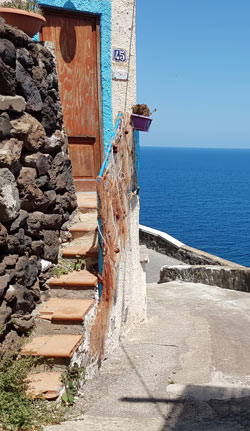
On this site
South to Calabria: a travel itinerary finishing in the Aeolian Islands
Hotels in Italy – what to expect
Useful external links
Salina hotels, B&Bs & apartments
Salina bus timetables (under orari)
Ferries
